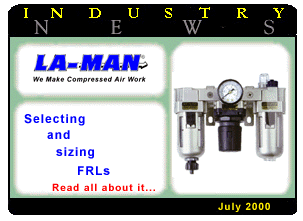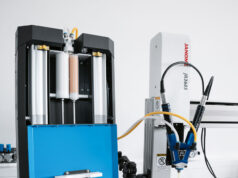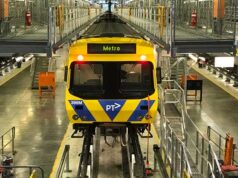By H. M. Shawl
Compressed air is widely used throughout industry and is often considered the fourth utility at many facilities. Uses include powering pneumatic tools, packaging and automation machinery, conveying and mixing bulk materials, spraying coatings, and providing breathing air Different tools and process operations require different pressures and purity levels. Air tools are designed to provide increased productivity, long service life, and safe operation. Pneumatic tool manufacturers rate tools for specific pressures. Process engineers specify precise pressures for every, process operation. Compressed air is clean, readily available and simple-to-use, but it can be the most expensive form of energy in your facility. Unregulated or improper pressure settings can result in increased compressed air demand, which results in increased energy consumption. Excessive pressure can also increase equipment wear, resulting in higher maintenance costs and shorter tool life. A rule of thumb states that every 2-psig increase in operating pressure adds an additional 1% to compression energy cost. Point-of-use FRLs (filters, regulators and lubricators) are needed to ensure that every tool or process is receiving a clean, lubricated supply of compressed air at the proper pressure to provide peak performance.
Airline Filters
Reliability is one of the strongest reasons to use compressed air, and proper filtration is the key to maximizing reliability and longevity. Compressed air can carry condensed water, oil carryover from compressors, solid impurities (pipe scale and rust) generated within the pipelines, and wear particles from actuators. These contaminants can cause problems at every point of use, and should be removed by installing suitable filters.
Contaminant-particle size is measured in micrometers (um), which each represents one-millionth of a meter or 0.000039 of an inch. Filters are rated according to the minimum particle size that their elements will trap. Although filters rated at 40 to 60 PPM are adequate for protecting most industrial applications, many point-of-use filters are rated at 5 urn. Note that finer ratings increase the pressure drop through the filter, which equates to higher energy cost to compress the air. In addition, finer filters clog more rapidly, also increasing pressure drop. (In other words, while filters finer than necessary does not harm the downstream components, they will have a negative impact on air system operating cost.)

Most point-of-use filters claim to remove condensed water, typically via a form of cyclone separator at their inlet end, Figure 2. The water-removal efficiency of such filters is very dependent on the incoming air velocity. Therefore, these filters must be matched to the intended airflow, rather than acceptable pressure drop. If the filter is intended to remove moisture, an integral automatic float-type drain should be provided to periodically remove accumulated liquids from the filter bowl. Generally, such filters have transparent polycarbonate bowls, which allow easy visual inspection of the sump level. Numerous chemicals can attack this plastic material and it only performs well at pressures below 150 psig and temperatures between 40″ and 120° F. A metal bowl may be required when the filter could be subjected to conditions outside those limits, as well as when synthetic compressor lubricants, which often contain chemicals that are harmful to polycarbonate, are present.
Most oil entrained in a compressed air stream, as well as some of the condensed water, will be in the form of mists or aerosols that can pass through the openings in standard airline filters. Air for instruments, spray painting, and bulk-material conveying frequently requires the removal of such droplets. Coalescing-type filters. Figure 3, will accomplish this job. Aerosol carryover through such filters is commonly stated as parts per million (PPM) of oil vs. air
Coalescing filters are often rated to remove aerosols that are substantially smaller than the nominal size of the smallest solid particle that would be captured. Some models offer dual-stage filtration; the first removes solid particulates to protect the coalescing element in the second stage. Because all coalescing filters create a greater restriction to the airflow, pressure losses will be higher than those of conventional compressed air filters. Coalescing filters have an initial (or dry) pressure drop and a working (or saturated) pressure drop, both based on pressure and flow rate. The effective removal efficiency of such filters depends greatly on the air velocity passing through the filter assembly. Therefore, choose a coalescing filter based on acceptable oil carryover, expected airflow rate, and
pipe-connection size. A coalescing filter rated at 0.1 PPM will typically have a
clean, wetted pressure drop between 2 and 5 psig, while a high-efficiency filter
rated at 0.01 PPM can cause as much as 10 psig drop once it becomes wetted or fully saturated during service, Figure 4.
The Absorption-type filters
Critical applications, such as food processing or breathing air, may also require the removal of sub-micrometer oil and chemical particles which pass through even the most efficient coalescing filters. These applications call for the use of an absorption-type filter. These filters commonly contain activated-carbon granules, which absorb and retain any fine hydrocarbon aerosols and vapors. The oil is captured on the surface of the carbon material; therefore, these filters have a finite absorption capacity based on the total surface area of active carbon available. Pressure loss through absorption filters is normally quite small and should not present a problem unless the specific vessel design causes excessive pressure drop. Such filters should be selected based on the total airflow to be processed and pipe connection size.
Pressure regulators
Once a minimum suitable operating pressure has been determined for any compressed air application, it ‘is essential to supply the air at a constant pressure, regardless of upstream flow and pressure fluctuations. Thus it is critical to install the proper regulator or pressure-reducing valve in the airline. Air regulators are special valves that reduce supply pressure to the level required for efficient operation of downstream pneumatic equipment. A filter to protect the regulator’s internal passages from damage should always be installed upstream from it.
There are several types of air regulators. The simplest type uses an unbalanced-poppet-style valve. This design incorporates an adjustment spring,does not have a separate diaphragm chamber, and is non-relieving. Turning the adjustment screw compresses the spring, which forces the diaphragm to move, thus pushing a poppet to uncover an orifice. As pressure rises downstream, it acts on the underside of the diaphragm, balancing against the force of the spring. The poppet throttles the orifice opening to restrict flow and produce the desired downstream pressure. A spring under the poppet assures that the valve closes completely when no flow exists. This is the least expensive type air regulator.
Larger, more expensive regulators, Figure 5, incorporate a separate diaphragm chamber, which has an aspirator tube exposed to the output pressure. Segregating the diaphragm from the main airflow minimizes its abrasive effects and extends the life of the valve. As flow through this regulator increases, the aspirator tube creates a slightly lower pressure in the diaphragm chamber. The diaphragm deflects downward and opens the orifice without significantly reducing the output pressure. The effect is the same as increasing the adjustment setting. Thus, this style regulator has minimal droop (output pressure decay) as supply pressure varies. Figure 6 compares how that variance occurs with a small and a large diaphragm. The larger diaphragms in these regulators improve response and sensitivity. As discharge flow through the regulator is increased over its entire range, output pressure droops, Figure 7. Thus it is important to set the regulator’s desired output pressure under normal flow conditions.
Another type of regulator incorporates a balanced poppet, but otherwise has the same general construction as the separate diaphragm version. It has a significantly larger orifice to allow for greater airflow. To maintain good stability, the poppet is pressure-balanced. Thus, the effects of output pressure fluctuations cancel out, which improves sensitivity and response, and reduces droop. Finally, precision regulators often employ several isolated diaphragms acting against flapper valves and nozzles in a balancing principle and are normally manufactured in limited flow capacities with smaller connection ports.
Selecting the best type of regulator for a specific application first requires a choice among these styles. Mini-regulators are commonly the direct-acting, non-relieving type, while most standard regulators fall within the self-relieving, separate-diaphragm chamber style. The next consideration becomes primarily (unregulated supply) pressure versus desired secondary (output) pressure. Finally, desired airflow rate must be selected. Adjusting screws are normally offered in two styles: tamper resistant, locking Tee type or push-lock, plastic knob type. The first is best when a Fixed operating pressure will be set once and left alone. The adjustable knob style (quite common on modular FRLs) is the correct choice for general
use, where the operating pressure can be easily adjusted without tools. Regulators also are defined by body size (orifice flow rating) and connection size. Although several models may appear to be acceptable for any given airflow and pressure, a larger body size regulator will produce better setting sensitivity and less droop than a smaller body model under the same set of operating conditions. An output pressure gage is essential, although many manufacturers frequently offer it only as an option. (Mounting brackets are another useful option.)
Airline lubricators
Many pneumatic system component and almost all pneumatic tools perform better when lubricated with oil. Injecting an oil mist into the air-stream which powers them can continuously lubricate valves, cylinders, and air motors for proper operation and long service life. Locating the lubricator properly in the pipeline is important to ensure that the correct amount of lubrication reaches each device. Too little oil can allow excessive wear and cause premature failure. Excessive oil in the pipeline is wasteful and can become a contaminant in the ambient area as it is carried out of tools and valves by the air exhaust. Intermittent lubrication may be the worst condition of all because the oil film can dry out and form sludge or varnish on the internal surfaces of the equipment.

Lubricators typically have a larger flow range than an equivalent size regulator or filter, but their pressure drop increases quite rapidly as flow increases, Figure 9. The acceptable pressure loss for a lubricator is normally considered to be 3 to 7 psig. Lubricators are generally selected based on pipe connection size, oil reeservoir capacity, and acceptable pressure loss versus flow rate (many manufacturers publish a minimum flow rate at which the venturi will function properly). Remember to account for this added downstream pressure loss when setting the pressure regulator. Set it at desired use pressure plus lubricator loss (drop).
Modular or combination units
Manufacturers frequently preassemble filters, regulators, and lubricators to form combination units, Figure 10. They are packaged together as common body sizes with common connection port sizes. Interconnections may be via threaded nipples or modular face connectors. The modular connectors allow easy removal of components for servicing or cleaning. In addition, some manufacturers combine Filters and regulators in stacked assemblies where the filter head becomes the regulator body. The components share common inlet and outlet connections, which makes the assembly very compact.
Such packaged units, whether FR only or FRL complete, are practical choices for most industrial applications. The selection criteria are the same as with any of the individual components, except that the combined pressure and flow performance becomes the only consideration. Note that when critical requirements dictate the use of specialty filters or precision regulators; the assembly probably must be made up of individual selections and connected with pipe nipples.

















